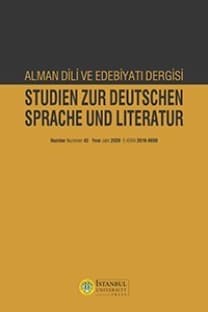Paradigmen des Pikaresken in Kumpfmüllers Hampels Fluchten (2000), Terézia Moras Alle Tage (2004) Dimitré Dinevs Engelszungen (2003) und Helmut Kraussers Fette Welt (1992)
Paradigmas of picaresk in Kumpfmüller's Hampels Fluchten (2000), Terézia Mora's Alle Tage (2004), Dimitré Dinev's Engelszungen (2003) and Helmut Krausser's Fette Welt (1992)Spain is the birthplace of the picaresque novel. Via the modern picaro in Kumpfmüller's Hampels Fluchten (2000), Terézia Mora's Alle Tage (2004) Dimitré Dinev's Engelszungen (2003) and Helmut Krausser's Fette Welt (1992), we have reached the picaresque myth, the farthest extension of the essential picaresque situation, which can be characterized as the paradigmatic confrontation between an isolated individual and a hostil situation. The picaresque genre is a continuum where the writers' particular appropriation of picaresque texts and the readers expectations of the genre interact. He is an outcast, even if this role is the character's own choice rather than one imposed on him by society. The genre also respondes to formal innovations as the novel itself evolves, and the originally narrative structure is often replaced by approaches that are not even strictly biographical and by the introduction of multiple narrative voices (e.g. in Mora's Alle Tage). All the novels analyzed in the essay describe a young man of humble extraction who seeks to improve his lotagainst all kinds of obstacles - and the reader has to decide whether the modern pìcaro is primarily an upstart, a wanderer or a swindler.The initial goal of rising in society, which characterizes the original Spanish pÃcaros, remains a constant though the means of achieving that end, and the nature of the pÃcaro continually changes with the evolution of the socio-economic and ideological climate in each age and country.Although he is now seen sympathetically, the contemporary pÃcaro continues to be, however, someone living at the margins of society.Keywords / Anahtar Sözcükler: picaresque novel, modern pìcaro as an upstart, a wanderer and a swindler, picaresque situation: paradigmatic confrontation (isolated individual-hostil situation)
Anahtar Kelimeler:
picaresque novel, modern pìcaro as an upstart, a wanderer and a swindler, picaresque situation: paradigmatic confrontation (isolated individual-hostil situation)
Paradigmas of picaresk in Kumpfmüller‘s Hampels Fluchten (2000), Terézia Mora‘s Alle Tage (2004), Dimitré Dinev‘s Engelszungen (2003) and Helmut Krausser‘s Fette Welt (1992)Spain is the birthplace of the picaresque novel. Via the modern picaro in Kumpfmüller‘s Hampels Fluchten (2000), Terézia Mora‘s Alle Tage (2004) Dimitré Dinev‘s Engelszungen (2003) and Helmut Krausser’s Fette Welt (1992), we have reached the picaresque myth, the farthest extension of the essential picaresque situation, which can be characterized as the paradigmatic confrontation between an isolated individual and a hostil situation. The picaresque genre is a continuum where the writers’ particular appropriation of picaresque texts and the readers expectations of the genre interact. He is an outcast, even if this role is the character’s own choice rather than one imposed on him by society. The genre also respondes to formal innovations as the novel itself evolves, and the originally narrative structure is often replaced by approaches that are not even strictly biographical and by the introduction of multiple narrative voices (e.g. in Mora’s Alle Tage). All the novels analyzed in the essay describe a young man of humble extraction who seeks to improve his lot against all kinds of obstacles - and the reader has to decide whether the modern pìcaro is primarily an upstart, a wanderer or a swindler.The initial goal of rising in society, which characterizes the original Spanish pícaros, remains a constant though the means of achieving that end, and the nature of the pícaro continually changes with the evolution of the socio-economic and ideological climate in each age and country. Although he is now seen sympathetically, the contemporary pícaro continues to be, however, someone living at the margins of society.
- Başlangıç: 1954
- Yayıncı: İstanbul Üniversitesi
